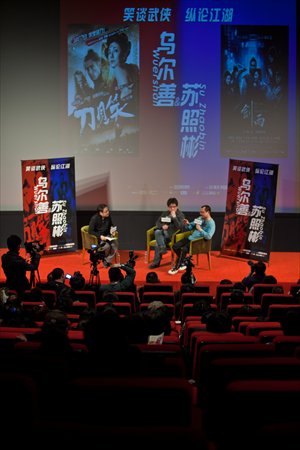Devoted but frustrated audiences

2010 panel held for director Wuershan's film The Butcher, the Chef and the Swords at BC MOMA.Photo: CFP
"It's better than people think," said Wu Jing, referring to the latest reports about the financial loss China's art theaters are suffering.
Wu is the content manager of Broadway Cinematheque MOMA (BC MOMA), one of the three art theaters in Beijing. The other two are located at the China Film Archive (CFA) and Ullens Center for Contemporary Art (UCCA).
"Of course we don't make much money [from the theater], but it's not so hard," she told the Global Times.
News that BC MOMA will open a new branch in Shanghai has ignited debate about domestic art theaters. Few film sources, a lack of talent and poor investment returns have led most media to paint a bleak future for the venues.
"What's the way out for China's art theaters?" asked a report by The Beijing News, pointing to the slow and arduous development of China's art theaters.
"We have the intention of opening a new branch in Shanghai, but it's still in discussion," said Wu. For BC MOMA, opening a new branch seems like a necessity, given the sparsity of art theaters.
Three niches
As the most concentrated place for art films, Beijing has the best art theaters in China. Despite the small quantity, the three art theaters in Beijing have distinguishing traits.
The art theater in UCCA, sponsored by the Ullens couple, Guy and Myriam Ullens, is one of the few theaters in China engaged in supporting the country's independent films, offering supplementary activities like lectures and dialogue between directors and audiences. Though there is only one projection room that seats 139 people, the UCCA theater attracts many producers and guests each year.
"The theater in UCCA used to be the lecture hall," said Cui Qiao, vice president of UCCA. "It turned into a movie theater in 2009 and is mainly used for public activities."
As a State-owned institution, money and film sources are minor problems for CFA compared to its peers. CFA opened in 1996 and boasts a collection of nearly 30,000 old films. CFA is more academic, showing classic Chinese and foreign movies. Collecting and repairing old movies is a specialty.
By the end of 2011, it repaired over 90 old domestic films and started to present classic series, including Story of Liubao Village (1957), Xiaohua (1979) and Peacock Princess (1982). CFA also regularly exhibits movies from foreign countries.
"We are not just showing art movies, but good movies across the world," said Sha Dan from CFA. "We are obligated to popularize them."
Some call BC MOMA the more "fashionable" and "international" of the three. Established in 2009, it screens popular movies like The Piano in a Factory (2011), and You Are the Apple of My Eye (2011), also released in commercial cinemas.
BC MOMA also screens domestic movies that have won awards in international film festivals but have little chance of entering domestic commercial cinemas, along with foreign art movies approved by the authority.
Eager audiences
A documentary professional, Liu Congqian is familiar with all three places. "When I was a student, I used to frequent them to acquire academic material or watch films not screened at regular cinemas," said Liu. "Now as I work in this industry, these places bring me different inspirations."
Like Liu, most art film audiences see cinemas as learning grounds where they can satisfy their interest, unlike regular audiences who might go to cinemas merely to catch a trendy flick, or satiate boredom.
To develop their audience base, BC MOMA adopted the membership system. It currently has around 7,000 members and regularly hosts general meetings for members to interact with movie directors or among themselves.
"Audiences at the CFA are sophisticated," said Sha Dan. "They watch until the end, applaud, then leave. Many are knowledgeable about film. If they discover something wrong with the screening quality, they will tell us. They are the cream of the crop for movie audiences in China," Sha said.
According to Wu, a good quality art movie sells well in Beijing. The same is less likely to happen in Hong Kong, where BC's first art theater opened in 1996.
"We have developed a group of loyal audiences invested in art films, a major achievement in the past three years," said Wu.
"We are not short of quality audiences, but good art films," Wu added. "Many people can only watch classic Chinese and foreign films on the Internet," said Sha. "They will support watching these movies in theaters."
Disproportionate development
Compared to growing audiences, the quantity of art theaters and the quality of art films is disproportional.
"In Beijing, we have 20 million people but only three art theaters. Berlin has over 100 different art theaters for a population of 4 million," said Cui Qiao.
In March, domestic director Jia Zhangke said on Sina Weibo that he is planning on building a 100-seat single-hall art theater, which was enthusiastically received by insiders.
Art theaters rose in the 1970s in the West, when Hollywood films squeezed out productions made by smaller studios. The latter turned to art theaters to screen their non-mainstream films.
Foreign countries also find it difficult for art theaters to hit profits, often supplementing through food sales and video products.
Lack of quality domestic art films along with limited quotas for imported films each year threatens the survival of domestic art theaters.
"Art films are part of the movie industry," said Wu. If the overall film industry is underdeveloped, the development of art theaters is affected.